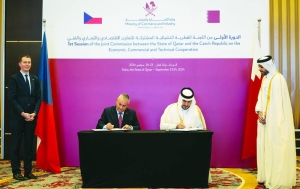Middle Eastern airlines take off

The rise of Middle East-based airlines is a significant development in the global economy. Expansion is not restricted to the best known carriers such as Qatar Airways, Etihad and Emirates. Turkish Airlines and Istanbul-based Pegasus Airlines carried 115mn passengers in 2023, up 10% on 2019, the last pre-pandemic year, helped by modernisation and expansion of Turkish airports.
Demand for air travel fell precipitously during the Covid-19 pandemic, especially in 2020, when passenger numbers fell to 1.8bn, from 4.5bn the year before. Revenues per passenger kilometre (RPK), a commonly used industry metric, fell by 66%. Only this year has traffic recovered to levels close to pre-pandemic levels.
Barring a similar unexpected disruption, however, demand is projected to grow. While the pandemic hit revenues of all airlines severely, some survived better than others, and were able to hire staff from bankrupt competitors and purchase valuable landing slots during the downturn. So the industry, on aggregate at least, recovered swiftly.
Much of the rising demand for air travel is fuelled by the rising middle class within Asia, the Middle East and Africa. People have a natural desire to travel, and the combination of rising incomes and affordable air travel makes this possible for a rising proportion of the world’s population. Social media has an influence, by multiplying the means by which people can gain a glimpse of attractive tourist destinations.
In total, the Middle East is adding significantly to airport capacity, projected to be able to handle 1.1bn passengers by 2040, more than double the level of 2019, which was 405mn. For example, Dubai is investing $35bn in a major airport expansion, and its home base carrier Emirates is ordering 90 Boeing 777s, while flydubai is ordering 30 Boeing 787s. Hamad International Airport is undergoing a major expansion; the King Abdelaziz Airport in Saudi Arabia is adding a new terminal, while the Hajj and Umrah terminal at Jeddah will handle 15mn passengers a year. Tourism, much of it religious pilgrimage, is the second most important industry in Saudi Arabia after oil. A major airport is being planned for Neom. There are plans for airport expansion also in Oman, Lebanon and Bahrain.
Some of these expansions are on a scale that other regions would find difficult to match. A geographical advantage that desert nations possess, especially compared with densely populated Western Europe, is space to construct airports with four, five or six parallel runways.
Another strategic advantage is being located between Africa, Europe and Asia, such that a high proportion of the world’s population lies within just a few hours’ flight. Gulf states have successfully marketed themselves as short-stay tourism destinations for travellers breaking their journey between Asia and the west.
In addition to airlines from Turkiye and the Gulf, Air India has launched a major investment programme since privatisation and ownership by Tata in 2022. Last year it confirmed a colossal investment of $34bn in some 450 new aircraft, split roughly evenly between Boeing and Airbus. Air travel by the Indian population is growing rapidly, both domestically and internationally.
Middle Eastern airlines typically enjoy a lower cost base compared with European airlines. Labour costs are lower, and the European Union has stricter environmental laws, for example requiring airlines to begin using fuel with lower emissions, that is more expensive. At an industry conference in March, leaders of Lufthansa and KLM-Air France acknowledged that they could not compete with Asian airlines for some long-distance routes. Lufthansa, for example, used to have direct flights to 14 destinations in southeast Asia, but this is reduced to just two, Bangkok and Singapore.
As aviation continues its recovery from the pandemic – which was its biggest peace-time disruption – a different industry, distinctly more Middle Eastern and Asian, is emerging.







